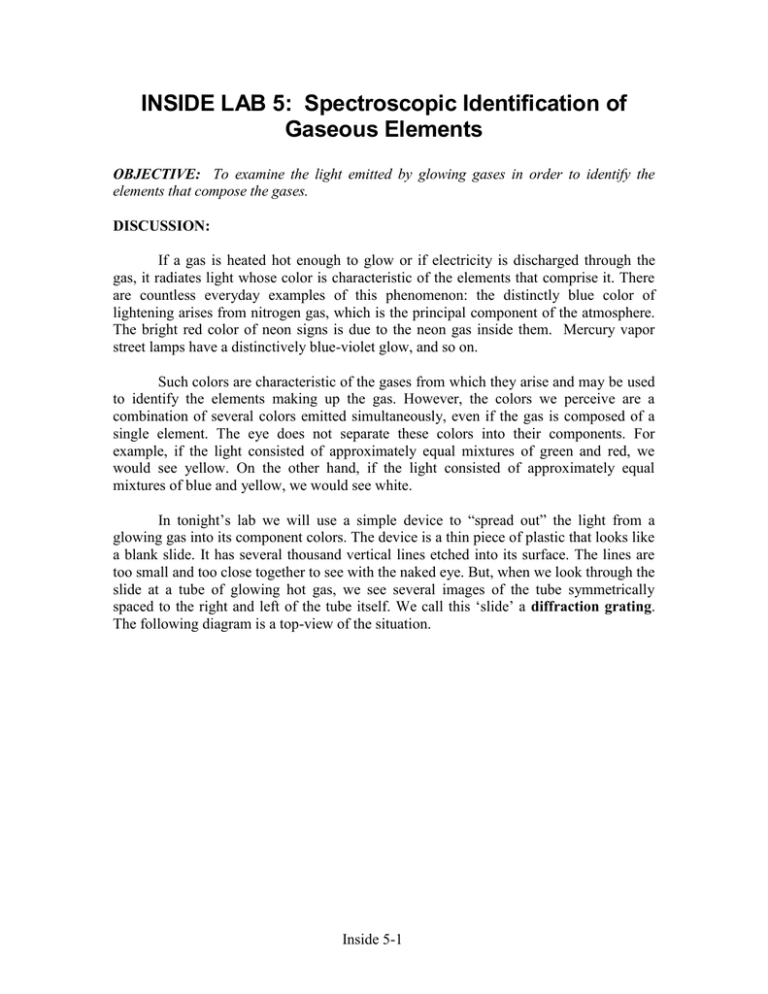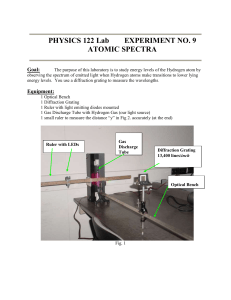INSIDE LAB 5: Spectroscopic Identification of Gaseous Elements
advertisement

INSIDE LAB 5: Spectroscopic Identification of Gaseous Elements OBJECTIVE: To examine the light emitted by glowing gases in order to identify the elements that compose the gases. DISCUSSION: If a gas is heated hot enough to glow or if electricity is discharged through the gas, it radiates light whose color is characteristic of the elements that comprise it. There are countless everyday examples of this phenomenon: the distinctly blue color of lightening arises from nitrogen gas, which is the principal component of the atmosphere. The bright red color of neon signs is due to the neon gas inside them. Mercury vapor street lamps have a distinctively blue-violet glow, and so on. Such colors are characteristic of the gases from which they arise and may be used to identify the elements making up the gas. However, the colors we perceive are a combination of several colors emitted simultaneously, even if the gas is composed of a single element. The eye does not separate these colors into their components. For example, if the light consisted of approximately equal mixtures of green and red, we would see yellow. On the other hand, if the light consisted of approximately equal mixtures of blue and yellow, we would see white. In tonight’s lab we will use a simple device to “spread out” the light from a glowing gas into its component colors. The device is a thin piece of plastic that looks like a blank slide. It has several thousand vertical lines etched into its surface. The lines are too small and too close together to see with the naked eye. But, when we look through the slide at a tube of glowing hot gas, we see several images of the tube symmetrically spaced to the right and left of the tube itself. We call this ‘slide’ a diffraction grating. The following diagram is a top-view of the situation. Inside 5-1 Red Image Blue Image Diffraction grating Gas tube Eye Blue Image Red Image Top view of the gas discharge tube and its images formed by the diffraction grating. Notice that we have pairs of images, two red and two blue images. Note also the symmetry: moving out from the tube to the right, we encounter a blue image and then a red; the same pattern holds if we move out from the tube to the left. (These are just example colors- you may not see blue or red in tonight’s lab.) In the first part of the lab, you will explore the images produced by the gas tube at your table. EXERCISES: EXERCISE 1: Have your TA turn on the electrical current for the gas tube at your desk. WARNING: The tubes are at a very high voltage and will get very hot. Be careful not to touch the tubes and especially do not touch the metal leads at either end of the tube as serious injury such as the loss of part of a finger could result. Looking through the diffraction grating at your desk, note the images of the tube spread out to the right and left of the tube itself. Notice that each image on the right side of the tube has a partner symmetrically placed on the left side. Make a record of what you see. You can record any data you wish, but someone not in the lab must be able to look at your data and re-create a scale drawing of your observations (with the correct colors and distances). Important: treat every left-right pair of images that you see distinctly, no matter how close together two images appear to be, or how dim any image is. Record your data in the space below and on the next page. Use the back of this page if necessary. Inside 5-2 Inside 5-3 You probably encountered some difficulty in identifying the different colors produced by the tube at your desk. (“Is that sea green or just green?”) Fortunately, we have a way of objectively identifying the ‘color’ of the images: the wavelength of the light. Wavelength is what your brain interprets as color. Look again at the figure above and note the angles. It turns out that there is a direct relationship between the wavelength of an image and the angle subtended at the diffraction grating: = a sin (1) where a is the average distance between the lines etched into the surface of the diffraction grating. a is called the grating constant. This number is penciled on the white border of the grating (or can be obtained from your TA). Knowing the grating constant and measuring angle , we can determine the distinct wavelengths of light emitted by a given incandescent gas. EXERCISE 2: Find a way to determine sin for each image you saw in Exercise 1, using the data you gathered in that part of the lab. (If you need to make more measurements, go ahead and do so.) In the space below write a few sentences describing what you decided to do. If you’re having trouble with this, ask your TA; you can’t complete the rest of the lab before finishing this part. Procedure for finding sin: Inside 5-4 EXERCISE 3: Using your data and equation (1), determine the wavelengths of light emitted by the gas at your table. Use the space below to record your results. Inside 5-5 EXERCISE 4: Repeat Exercises 1, 2, and 3 for another gas tube in the lab. Your TA will change the gas tubes for you. Make sure that each new tube has a different overall color. Use the space below to record your data and results. (You don’t have to describe again your procedure for finding sin, just the results.) Inside 5-6 EXERCISE 5: What are these gases? Compare your calculated wavelengths to the standard values below, and identify the element in each of the tubes you have investigated. Hydrogen (H) 0.6563 m 0.4861 m 0.4340 m Helium (He) 0.6678 m 0.5876 m 0.5016 m 0.4471 m Mercury (Hg) 0.5770 m 0.5461 m 0.4358 m Standard wavelengths for Hydrogen, Helium, and Mercury. (A ‘m’ is a ‘micro-meter,’ which is 10-6 meters. A typical atom is about 0.0001 m in diameter.) Gas 1: Overall Color_________________ Identity________________________ Gas 2: Overall Color_________________ Identity________________________ EXERCISE 6: Explain how the work you have done could be used in stellar astronomy. What types of things could you learn about stars? Inside 5-7 EXERCISE 7: When a source of light is moving toward or away from you, the wavelengths of light it emits are shifted relative to their ‘laboratory values,’ i.e., the values measured if the object is not moving with respect to you. If the object is moving away from you, all of the wavelengths of light are shifted to larger values. If the object is moving toward you, the wavelengths are shifted to smaller values. The amount of the shift is the same for each wavelength of emitted light, and depends only on the relative velocity between you and the object. This is called a Doppler shift. We use 0 to stand for the laboratory value of a given wavelength. The shifted wavelength 1 is related to 0 by vr 1 0 c 0 where vr is the velocity of the object, and c is the speed of light (3105 km/s). If one of your gases above was Helium: An astronomer observing a nebula measures the bright red Helium line to be at a wavelength of 0.6800 m. Comparing this to the laboratory value that you measured above, answer the questions below. If neither of your gases above was Helium but one was Hydrogen: The astronomer finds the red Hydrogen line at a wavelength of 0.8000 m. Compare this to the laboratory value that you measured above and answer the questions below. Is the nebula moving toward us or away from us? What is its velocity? Inside 5-8

